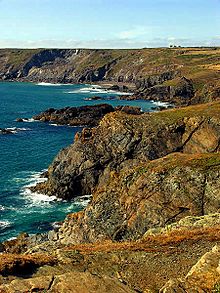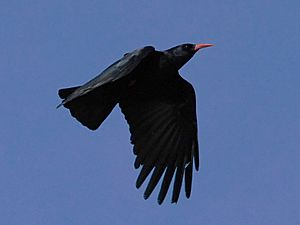Caerthillian to Kennack facts for kids
| Site of Special Scientific Interest | |

Cliffs on the western side of the SSSI
|
|
| Area of Search | Cornwall |
|---|---|
| Coordinates | 49°58′58″N 5°10′51″W / 49.9829°N 5.1809°W |
| Interest | Biological/Geological |
| Area | 141.1 hectares (1.411 km2; 0.5448 sq mi) |
| Notification | 1951 |
Caerthillian to Kennack is a special coastal area in Cornwall, UK. It is known as a Site of Special Scientific Interest (SSSI) because of its amazing plants, animals, and unique rocks. This place is super important for rare and endangered plants. It's also a breeding spot for the Cornish chough, a special bird.
Contents
What is the Caerthillian to Kennack SSSI?
This special area covers about 141 hectares (that's like 350 football fields!). It stretches along the south coast of the Lizard Peninsula. This includes the most southerly point of Great Britain. The SSSI goes from Caerthillian Cove in the west to Kennack Sands in the east.
The famous South West Coast Path runs right through this area. Most of the coastline here is looked after by the National Trust. This SSSI is also part of the Lizard National Nature Reserve. It even has two spots that are important for studying geology.
When Was This Area Recognized?
The Caerthillian to Kennack SSSI was first officially recognized in 1951. Back then, it was called the South and East Lizard SSSI. Its name changed later when its boundaries were made bigger and smaller.
The rocks off this coast have always been dangerous for ships. Many ships have been wrecked here over the years. The The Lizard Lifeboat Station, which helps rescue people at sea, is also located within this SSSI.
What Makes the Geology Special?
The rocks in this area are part of something called the Lizard complex. This is a very old and unique set of rocks. It includes types like micaceous and hornblende schist. On top of these, you'll find serpentinized peridotite and gabbro. There are also some granite gneiss rocks mixed in.
Amazing Wildlife and Nature
This SSSI is home to a fantastic mix of plants and animals. The mild, moist climate from being near the ocean helps. Also, the special serpentine soils and strong winds create unique growing conditions. Many rare plant species thrive here.
Unique Plants of Caerthillian to Kennack
The site has many different types of natural homes for plants. On the south-west side, you'll find plants that love coastal cliffs. These include sea aster, rock samphire (Crithmum maritimum), and sea thrift. Higher up the cliffs, you can see red fescue, sea carrot (Daucus carota), Yorkshire fog, and cock's-foot (Dactylis glomerata). The nationally rare Scilla autumnalis also grows here.
The eastern side of the SSSI is protected from the strong westerly winds. This means that less hardy plants can grow in the cliff scrub areas. You might find blackthorn (Prunus spinosa), common gorse (Ulex europaeus), and wild privet (Ligustrum vulgare). There are also woodland plants like common dog-violet (Viola riviniana), common honeysuckle (Lonicera periclymenum), hart's-tongue (Phyllitis scolopendrium), and red campion (Silene dioica).
At an old serpentinite quarry in Church Cove, you can find three plants that are nationally scarce. These are galingale (Cyperus longus), yellow-vetch (Vicia lutea), and bird’s-foot clover (Trifolium ornithopodioides).
The only cliff woodland on the Lizard Peninsula is near a place called the Devil’s Frying Pan. This used to be a sea cave that collapsed. This woodland has Cornish elm, Dutch elm, and a mix of elm varieties. Other woodlands are found inland around Poltesco.
Some of the rarest plants in the UK are found here. These include Cornish heath (Erica vagans), early meadow-grass (Poa infirma), fringed rupturewort (Herniaria ciliolata), long-headed clover (a type of Trifolium incarnatum), and wild asparagus (a type of Asparagus officinalis). There are only two places in mainland Great Britain where you can find four-leaved allseed (Polycarpon tetraphyllum), and one of them is right here!
Animals of Caerthillian to Kennack
A special bird called the Cornish chough (Pyrrhocorax pyrrhocorax) breeds on the cliffs here. These crow-like birds are very rare in Cornwall. In 2002, a pair of choughs laid eggs in a cave at Lizard Point. This was the first time choughs had bred in Cornwall in 50 years! Since then, other pairs have also started breeding around Cornwall.


